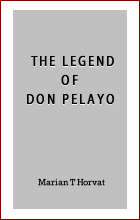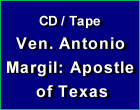Stories & Legends
 |
 |
 |
 |
 |
 |
 |
The Conversion of a Saracen Prince
A Saracen prince named Amerumnes had occasion to send his nephew to the town of Amplona in Syria, where a splendid church had been erected and dedicated to St. George. As soon as the Saracen saw this church from afar, he told his servants to stable the camels there and put their fodder upon the altar.
 On arriving they prepared to execute these orders, but the priest interposed, warning the servants against such a desecration of the house of God. Their master paid no heed to this remonstrance. The camels were driven into the church. As soon as they crossed the threshold, however, they fell down dead. This alarmed the Saracen, and he commanded his followers to remove the bodies of the camels from the church.
On arriving they prepared to execute these orders, but the priest interposed, warning the servants against such a desecration of the house of God. Their master paid no heed to this remonstrance. The camels were driven into the church. As soon as they crossed the threshold, however, they fell down dead. This alarmed the Saracen, and he commanded his followers to remove the bodies of the camels from the church.
The day this occurred happened to be a festival, and a large congregation had assembled to hear Mass. The priest was wary to begin, for he dreaded some new act of profanation on the part of the Saracen, who had stationed himself near the altar so that he might observe the ceremonies of the Mass.
The Saracen watched attentively. When the celebrant, according to the Greek rite, divided the consecrated Host into four parts with a knife, it appeared to the interested onlooker as if he were cutting the flesh of a beautiful child, whose blood flowed into the chalice.
Roused to indignation at this sight, he would have run the priest through with his sword on the spot had curiosity not restrained him as to what would happen next. When, at the time of communion, the priest consumed the Sacred Elements, to the eyes of the Saracen they bore, not the semblance of bread and wine, but of real Flesh and Blood.
In every Host administered to the communicants he observed the same appearance. "What barbarians these Christians must be!" he said to himself. "At their idolatrous rites they slay a child, whose flesh they eat. I will surely avenge the cruel murder of this innocent babe, and put these savage monsters to a miserable end."
At the conclusion of the Mass the priest distributed the eulogia, or blessed bread, to the people, and gave a piece to the Saracen.
 "What is this? " he angrily asked, suspecting some new horror. The priest answered: "It is blessed bread."
"What is this? " he angrily asked, suspecting some new horror. The priest answered: "It is blessed bread."
Then the unbeliever exclaimed aloud: "Is this what you offer upon the altar, inhuman wretch? Have I not myself seen you slay a sweet Child with your own hands, eat His Flesh, and drink His Blood? And did you not afterwards give it to the others?"
The priest, amazed beyond expression, replied humbly: "My lord, I am a sinner, unworthy to look upon mysteries so sublime. Since you have been privileged to behold them, you must enjoy great favor with God."
The Saracen then asked whether what he had seen was true. The priest replied that indeed it was, but to the eyes of sinful man it was not given to penetrate this deep mystery, and he himself saw nothing more than bread and wine, which by the words of consecration were changed into the Body and Blood of Christ.
The Saracen was so deeply impressed by what he had seen and heard that he expressed the wish to become a Christian, and asked to be baptized.
But the priest, fearing the anger of the prince's uncle, refused to comply immediately with his request. Instead, he instructed him that, if he were in earnest, he should present himself to the Bishop on Mount Sinai and relate to him what he had witnessed. The Bishop would then instruct him in the Catholic Faith and admit him to holy Baptism.
So, the Saracen returned to his followers, without, however, telling them a word of what had passed. Under cover of night, disguised in a pilgrim's cloak, he secretly departed and made his way to Mount Sinai, where he acquainted the Bishop with the cause of his conversion.
He was duly instructed and baptized with the name of Pachomius, the famous Eastern monk. Later on, he himself became a monk. After three years spent in austere penance, he returned, with his superior's permission, to his home, in the hope of converting his father. He was, however, put to cruel torture and finally stoned to death.
God willed that this occurrence should be recorded and handed down to posterity, to increase our knowledge, and confirm our faith in this transcendent Mystery.



A Saracen prince tries to desecrate a church
The day this occurred happened to be a festival, and a large congregation had assembled to hear Mass. The priest was wary to begin, for he dreaded some new act of profanation on the part of the Saracen, who had stationed himself near the altar so that he might observe the ceremonies of the Mass.
The Saracen watched attentively. When the celebrant, according to the Greek rite, divided the consecrated Host into four parts with a knife, it appeared to the interested onlooker as if he were cutting the flesh of a beautiful child, whose blood flowed into the chalice.
Roused to indignation at this sight, he would have run the priest through with his sword on the spot had curiosity not restrained him as to what would happen next. When, at the time of communion, the priest consumed the Sacred Elements, to the eyes of the Saracen they bore, not the semblance of bread and wine, but of real Flesh and Blood.
In every Host administered to the communicants he observed the same appearance. "What barbarians these Christians must be!" he said to himself. "At their idolatrous rites they slay a child, whose flesh they eat. I will surely avenge the cruel murder of this innocent babe, and put these savage monsters to a miserable end."
At the conclusion of the Mass the priest distributed the eulogia, or blessed bread, to the people, and gave a piece to the Saracen.

The Saracen sees the Christ Child in the Host & converts
Then the unbeliever exclaimed aloud: "Is this what you offer upon the altar, inhuman wretch? Have I not myself seen you slay a sweet Child with your own hands, eat His Flesh, and drink His Blood? And did you not afterwards give it to the others?"
The priest, amazed beyond expression, replied humbly: "My lord, I am a sinner, unworthy to look upon mysteries so sublime. Since you have been privileged to behold them, you must enjoy great favor with God."
The Saracen then asked whether what he had seen was true. The priest replied that indeed it was, but to the eyes of sinful man it was not given to penetrate this deep mystery, and he himself saw nothing more than bread and wine, which by the words of consecration were changed into the Body and Blood of Christ.
The Saracen was so deeply impressed by what he had seen and heard that he expressed the wish to become a Christian, and asked to be baptized.
But the priest, fearing the anger of the prince's uncle, refused to comply immediately with his request. Instead, he instructed him that, if he were in earnest, he should present himself to the Bishop on Mount Sinai and relate to him what he had witnessed. The Bishop would then instruct him in the Catholic Faith and admit him to holy Baptism.
So, the Saracen returned to his followers, without, however, telling them a word of what had passed. Under cover of night, disguised in a pilgrim's cloak, he secretly departed and made his way to Mount Sinai, where he acquainted the Bishop with the cause of his conversion.
He was duly instructed and baptized with the name of Pachomius, the famous Eastern monk. Later on, he himself became a monk. After three years spent in austere penance, he returned, with his superior's permission, to his home, in the hope of converting his father. He was, however, put to cruel torture and finally stoned to death.
God willed that this occurrence should be recorded and handed down to posterity, to increase our knowledge, and confirm our faith in this transcendent Mystery.

Adapted from Martin von Cochem, Explanation of the Holy Sacrifice of the Mass,
NY: Benzinger Bros., 1896, pp. 117-120
Posted August 22, 2018
NY: Benzinger Bros., 1896, pp. 117-120
Posted August 22, 2018






